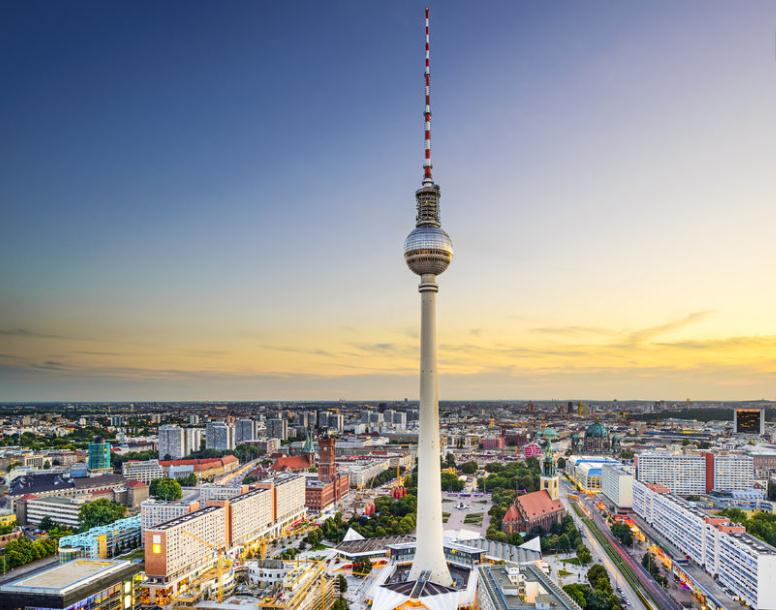
A Journey Through History: A One-Day Walking Tour of Berlin's Core
Berlin is not merely a city; it is a living, breathing history book. Its streets and structures narrate tales of empire, war, division, and rebirth. This detailed walking tour is designed to guide you through the very heart of this narrative, connecting the iconic symbols of Berlin's turbulent past and vibrant present. The route is logical and mostly walkable, allowing you to absorb the immense atmosphere of the German capital. We begin at a central meeting point and embark on a journey through time.
Starting Point: The Central Hub - Pariser Platz
Your journey begins at
Pariser Platz (Parisian Square), the grand square that serves as the ceremonial entrance to the city. This is more than just a convenient meeting spot; it is a statement. Flanked by embassies, the luxurious Hotel Adlon, and the Akademie der Künste (Academy of Arts), the square embodies Berlin's restored status as a world capital. As you stand here, consider that this very spot was a desolate no-man's-land during the Cold War, bisected by the Berlin Wall. The reconstruction of Pariser Platz after German reunification in 1990 was a profound symbol of healing and a return to normalcy.
Transportation Tip: The easiest way to reach Pariser Platz is via the S-Bahn (city train) lines S1, S2, S25, or S26 to the station "Unter den Linden." Alternatively, take the U-Bahn (subway) U55 to "Brandenburger Tor." Both exits place you right at the square.
Local Insight: Look at the cobblestones on the ground around the square. You will notice a double row of cobblestones tracing a path through the city. This is a permanent marker indicating where the Berlin Wall once stood, a subtle but powerful reminder under your feet.
First Stop: The Icon of Berlin - Brandenburg Gate (Brandenburger Tor)
Directly ahead of you on Pariser Platz stands the undisputed symbol of Berlin: the
Brandenburg Gate. This neoclassical triumphal arch, commissioned by King Frederick William II of Prussia in the late 18th century, was originally a symbol of peace. Its history, however, has been anything but peaceful. It has witnessed Napoleonic troops marching through, Nazi processions, and its position in the death strip of the Berlin Wall made it an inaccessible global icon of division. Perhaps its most joyous moment was on December 22, 1989, when the gate was reopened as over 100,000 people celebrated the fall of the Wall.
Attraction Details: The gate is crowned by the famous
Quadriga statue, a chariot drawn by four horses, driven by Victoria, the Roman goddess of victory. It's worth using a zoom lens or binoculars to appreciate the detail. The gate is best experienced from both sides – from Pariser Platz and then from the Tiergarten park side for a different perspective.
Cultural Aspect: Today, the Brandenburg Gate is a venue for major public events, from World Cup celebrations to the spectacular New Year's Eve party. It represents a unified Germany and serves as a backdrop for speeches by world leaders.
Photography Tip: Early morning offers the best light for photography and the fewest crowds. At night, the gate is beautifully illuminated, creating a magical and solemn atmosphere.
Second Stop: The Seat of Power - Reichstag Building (Berlin Congress Building)
A short five-minute walk north from the Brandenburg Gate brings you to one of the most important political buildings in the world: the
Reichstag Building. Home to the German parliament, the Bundestag, its history is a microcosm of Germany's own. Completed in 1894, it was the seat of government until the infamous
Reichstag Fire of 1933, which the Nazis used as a pretext to solidify their power. Heavily damaged in World War II, it was partially restored but stood as a symbol of a divided nation until reunification. The breathtaking glass dome, designed by architect Norman Foster, was added in the 1990s and is a masterpiece of symbolic architecture.
Attraction Details: The highlight of any visit is the dome. A spiraling ramp leads you to the top, offering 360-degree panoramic views of Berlin. An audio guide automatically triggers as you walk, explaining the landmarks you see and the workings of the parliament chamber below. The central cone of mirrors is an engineering marvel that provides natural light and ventilation to the plenary hall.
Practical Travel Tip: Entry to the Reichstag dome is FREE, but registration is MANDATORY. You must book your time slot well in advance (often weeks or even months) on the official Bundestag website. Bring your passport or official ID for security checks. If you haven't booked, you can try registering at the service centre across the street, but availability is not guaranteed.
Food Suggestion: The rooftop restaurant,
Kafer Dachgarten, offers excellent German cuisine with an unparalleled view. Reservations are essential and can also be made through the Bundestag website.
Third Stop: A Field of Memory - Memorial to the Murdered Jews of Europe
A few minutes' walk south of the Brandenburg Gate lies one of Berlin's most powerful and contemplative sites: the
Memorial to the Murdered Jews of Europe. Covering an area of 19,000 square meters, this abstract memorial consists of 2,711 concrete slabs (stelae) of varying heights, arranged in a grid pattern on a sloping field. The design is intentionally open to interpretation. As you walk into the undulating field, the ground descends, and the grey pillars rise around you, creating a sense of isolation, confusion, and unease.
Attraction Details: Beneath the field of stelae is the
"Place of Information" (Ort der Information). This underground museum is essential for contextualizing the memorial. It documents the lives and fates of individual victims through personal stories, letters, diaries, and photographs. It is a deeply moving and humanizing experience.
Cultural Aspect: The memorial's abstract nature was controversial but ultimately successful. It does not tell you what to feel; it creates an environment where you are compelled to reflect. Visitors are encouraged to walk among the stelae, and it is common to see people sitting on the lower blocks in quiet contemplation. Please be respectful; it is a place of remembrance, not a playground.
Local Insight: The memorial is deliberately located in the heart of Berlin, on land that was once part of the Nazi leadership's administrative district. By placing it here, Germany ensures that this memory is central to its modern identity and cannot be marginalized.
Fourth Stop: A Relic of the Cold War - Checkpoint Charlie
From the memorial, walk east for about 10-15 minutes along Zimmerstraße or Markgrafenstraße until you reach Friedrichstraße. Here you will find
Checkpoint Charlie, the most famous border crossing between East and West Berlin during the Cold War. It was used solely by Allied personnel, foreigners, and diplomats. The current setup is a reconstruction for tourists. You'll see a replica of the original guardhouse and soldiers' barracks, and actors dressed as American military police pose for photos (for a fee).
Attraction Details: While the checkpoint itself can feel kitschy, its historical significance is immense. This was the site of a tense standoff between American and Soviet tanks in 1961, just feet apart. The open-air exhibition panels along the street are excellent, detailing escape attempts—some successful, many tragic—and explaining the geopolitical context of the checkpoint.
Practical Travel Tip: Be prepared for crowds and commercialism. It's a hub for tourist activity. For a more profound understanding, cross the street to visit the
Mauermuseum – Museum Haus am Checkpoint Charlie. This privately-run museum is packed with artifacts related to escape attempts, including hidden compartments in cars and hot air balloons.
Food Suggestion: This is a good area for a quick bite. You can find numerous currywurst stands or casual cafes. For a more substantial meal, explore the side streets off Friedrichstraße.
Fifth Stop: Berlin's Grand Boulevard - Unter den Linden
From Checkpoint Charlie, head north on Friedrichstraße for a few blocks until you reach
Unter den Linden ("Under the Linden Trees"). This grand boulevard, stretching eastward from the Brandenburg Gate, is Berlin's historic ceremonial avenue. Lined with linden trees, it was laid out in the 17th century as a royal road connecting the City Palace with the Tiergarten hunting grounds. Today, it connects many of Berlin's most important cultural and scientific institutions.
Attraction Details: As you walk east, you'll pass by:
The Neue Wache (New Guardhouse): A moving memorial to the "Victims of War and Tyranny," centered on Käthe Kollwitz's powerful sculpture "Mother with her Dead Son."
Bebelplatz: Infamous as the site of the Nazi book burning in 1933. A memorial by Micha Ullman—a glass window set into the cobblestones showing empty bookshelves—commemorates this event.
The Berlin State Opera, Humboldt University, and St. Hedwig's Cathedral.
Cultural Aspect: Walking down Unter den Linden is a walk through Prussian grandeur. It represents Berlin's aspiration to be a "Spree-Athens," a center of culture and enlightenment. It's a perfect place for a leisurely stroll, people-watching, and admiring the unified architectural style.
Sixth Stop: The East Side Gallery & Remnants of Division - The Berlin Wall
The final major stop on our tour requires a short ride on public transport. From Unter den Linden, take bus TXL or M48 towards Ostbahnhof or walk to Alexanderplatz and take the S-Bahn to Ostbahnhof. Your destination is the
East Side Gallery, the longest remaining section of the Berlin Wall (1.3 km). After the Wall fell in 1989, 118 artists from 21 countries transformed this concrete barrier into an international memorial for freedom.
Attraction Details: This is not just a wall; it's an open-air gallery. The most famous painting is Dmitri Vrubel's "
My God, Help Me to Survive This Deadly Love" depicting the fraternal kiss between Soviet leader Leonid Brezhnev and East German President Erich Honecker. Other sections feature powerful political statements and vibrant art.
Practical Travel Tip: The East Side Gallery runs along Mühlenstraße on the banks of the River Spree. It's free to visit and accessible 24/7. Be aware that graffiti vandalism and weathering are constant threats to the original art; preservation efforts are ongoing.
Local Insight: To see the Wall in its original, grim state, visit the
Berlin Wall Memorial (Gedenkstätte Berliner Mauer) on Bernauer Strasse (a U-Bahn ride away). This site preserves a section of the border fortifications complete with the death strip and offers a deeply informative documentation center.
The Return Journey & Final Reflections
From Ostbahnhof station adjacent to the East Side Gallery, you have excellent transport connections back to any central location in Berlin. Take any S-Bahn line (S5, S7, S75) heading west towards Alexanderplatz or Hauptbahnhof.
This single day's walk has taken you through centuries of German history: from Prussian monarchy at Brandenburg Gate and Unter den Linden, through the catastrophic era of Nazism and Holocaust at the Memorial, into the divided Cold War city at Checkpoint Charlie and the Wall, and finally to its modern rebirth as a democratic capital at the Reichstag. Each site tells a part of Berlin's complex story—a city that confronts its past with remarkable honesty while energetically building its future.
Summary of Practical Tips
Transportation: Purchase a day pass for Berlin's public transport (AB zone) for unlimited travel on buses, trams, U-Bahn, and S-Bahn. It is efficient and cost-effective for this itinerary.
Footwear: Wear comfortable walking shoes. You will be on your feet for most of the day.
Sustenance: Stay hydrated and carry snacks. While there are plenty of options (from street food like currywurst and döner kebab to sit-down restaurants), having water on hand is crucial.
Planning: Book your Reichstag dome visit far in advance. Check opening times for museums you wish to enter (like the Topography of Terror or Mauermuseum).
Mindset: Come with respect and an open mind. You are visiting sites of great joy but also profound tragedy. Allow time for reflection.
A journey through central Berlin is more than sightseeing; it is an immersive historical education that will leave a lasting impression long after you have returned home.



